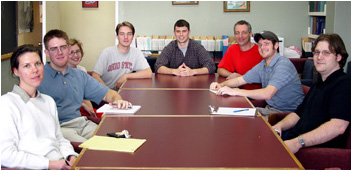The Communication
Factor
Newsletter of the Cain Project in Engineering and Professional
Communication at Rice University Spring -2004
Cain Project Home >> Newsletter
Cain Project Involved in New STAT, CAAM, and MATH Program
 The Developmental Biology Group Clockwise from Bottom left: Julie Zeleznik, Ben Smiley, Brooke Lathram, TJ Theron, Charlie Bingham, Robin Forman, Klyen Ragan, Ryan Krech |
In 2002 the Departments of Mathematics, Statistics, andComputational and Applied Mathematics proposed to the National Science Foundation (NSF) a new program to link faculty, graduate students, post-docs, and undergraduates in interdisciplinary research and learning teams that will involve all members in solving challenging, cutting-edge problems.
Mathematical sciences faculty realized that teams with such varied
levels of knowledge would need
excellent communication
skills in order to learn from one another and solve complex problems
collaboratively. In the proposal they included
funds for Cain Project instructors to coach teams in oral presentations,
writing, and design. It also called for special workshops on writing
for publication,
thesis writing, and other topics.
This new Rice VIGRE program (for Vertical Integration of Graduate Research
and Education) was exciting for the Cain Project because of the challenge
it offered
for coaching students with different backgrounds simultaneously. It also
provided a testbed for studying the communication processes of complex groups.
Furthermore,
because of the
interdisciplinary character of the teams’ research, which ranges from computational
finance and image
processing to biomathematics and gene
networks, students will have the opportunity learn about interdisciplinary communication
as well as traditional types of presentations and reports. Communication is at
the heart of interdisciplinary work, essential in
negotiating problem definitions, research designs, interpretation of evidence,
and presentation of results. Experience with these types of communication can
provide students with knowledge about dealing with complexity.
Two NSF Grants for Cain
To determine whether students participating in the VIGRE teams develop this kind
of interdisciplinary knowledge, the Cain Project requested funding to capture
communication and start-up data at the beginning of the VIGRE program. A grant
of over $41,000 was approved, and Julie Zeleznik and Linda Driskill began planning
how to study the interdisciplinary communication in the six teams. Julia Amborski,
Project Coordinator, planned the data collection.
Early in the research, Dr. Zeleznik
noticed that conflicting schedules of graduate students, undergraduates,
faculty, and post-docs in the vertically integrated groups made communication
difficult. Finding ways to ask questions or to collaborate on problem solving
caused delays and frustration. To address this problem, she and Dr. Driskill
requested a supplemental grant to create a Web-based on-line community for
each VIGRE group and for the VIGRE program as a whole.
This on-line community will not only store documents but will also allow m
embers to communicate easily, invite others to try pieces of computer code
or algorithms
that groups are developing, and comment on one another’s work. Each group
has a “home” that brings together in a single space both the group’s
research projects and materials as well as access to all the course materials
the team is using.
The site will have a public side as well, offering published papers, resource
links, and information about the research teams are conducting. The NSF approved
the supplemental grant of nearly $57,000 to support the on-line community,
which could become a model for other VIGRE programs across the country. Rice
University’s
Web Services group, headed by Andrea Martin, is implementing the plan for the
new on-line community.
When an innovation transforms traditional ways of learning and working, communication
instruction needs to consider new student roles, new access to learning resources,
and new types of communication suited to particular objectives. (See Zeleznik’s
account of her research.)